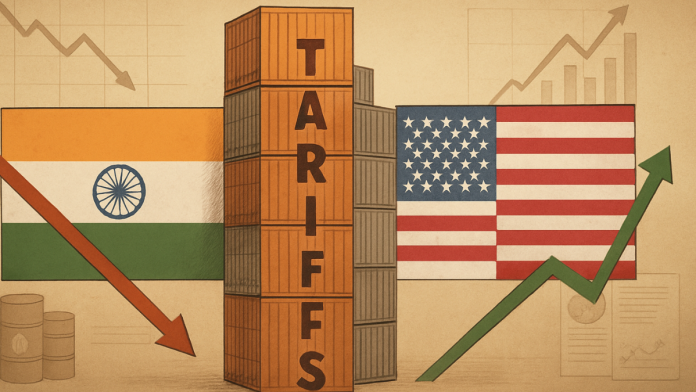India is facing one of its toughest trade challenges in recent years. A surprise decision by the United States to double tariffs on Indian goods has sent shockwaves through government and industry. The move, announced by President Donald Trump, directly links India’s oil purchases from Russia to heavy trade penalties. With the new 50% tariff rate kicking in on August 27, India now has just a few days to find a way out.
A Sudden Shock for Indian Trade
The US is India’s largest export market, accounting for $86.5 billion in annual goods trade. That’s nearly 18% of India’s total exports and contributes about 2.2% to the country’s GDP. The tariff hike from 25% to 50% is meant to punish India for continuing to buy Russian oil during the Ukraine war.
But this move could hit India hard. Economists warn that if these tariffs remain, they could drag India’s growth below 6%. Most Indian exporters say they cannot survive a 50% tax, especially in labor-heavy industries like textiles, gems, and jewelry. Electronics and pharmaceutical exports are exempt for now, but other sectors may not be so lucky.
According to Japanese financial firm Nomura, the impact of such high tariffs could feel like a trade embargo. Indian companies could stop exporting certain goods altogether. The Confederation of Indian Textile Industry (CITI) has already warned of a “huge setback” for exporters in that space.
🛢️ 50% tariffs, secondary sanctions warning: Trump’s crackdown pushes India to the edge
Three Main Options India Can Explore
Speed Up Trade Talks with the US
India and the US have been discussing a trade deal for some time, but progress has been slow. Talks were stuck on issues like agriculture and dairy. The US wants more access to these sectors, but India has remained firm.
With the tariff deadline nearing, India might now try to fast-track the discussions. A US delegation is visiting India this month. If some middle ground can be found—even in less sensitive areas—it might be enough to delay or ease the tariff hike.
Adjust Oil Policy Without Breaking Ties
The main reason for the US action is India’s continued purchase of Russian oil. India argues that these imports are based on market needs and help ensure energy security.
However, small changes in how India buys oil or signals of reduced dependency might help calm tensions. Dr. Chietigj Bajpaee of Chatham House points out that India has already been trying to cut back on military and energy ties with Russia. These efforts could now play a role in negotiations.
Trump’s 50% tariffs backfire? Modi reaches toward China with surprise SCO return after 7 years
Support for Exporters on the Ground
Indian exporters are already feeling the heat. With high tariffs making their products uncompetitive, many may be forced to stop shipping to the US.
India has avoided giving direct subsidies in the past, but that might change. Policy experts at Nomura suggest that existing support schemes may no longer be enough. Relief through tax benefits, easier trade loans, or emergency assistance for key industries could help keep factories running and jobs secure.
Redirecting exports to other countries is another option, though that shift takes time. Immediate support will be essential to cushion the blow if tariffs remain in place.
High-Stakes Diplomacy Underway
The situation places India in a tight spot. On one side is its strategic relationship with Russia. On the other is a fast-growing partnership with the United States. Both are important—but Washington’s strong response has put pressure on India to choose.
Russia slams US ‘neocolonial’ tariffs: Is America sabotaging global trade?
Former RBI Governor Urjit Patel called the tariff hike India’s “worst fears come true.” He warned that without quick diplomatic progress, a full-scale trade dispute may be on the horizon. Trade analysts agree that these next few weeks will be critical.
President Trump’s decision has also sparked political backlash in India. Congress leader Rahul Gandhi described it as “economic blackmail” and accused the US of trying to force India into a one-sided deal. Meanwhile, officials in New Delhi have stated that India will take all necessary steps to protect national interests.
India has retaliated in past trade disputes. In 2019, it imposed tariffs on 28 US products in response to earlier US tariffs. Some of those duties were removed in 2023 after WTO settlements.
With only days left before the 50% tariffs take effect, Indian policymakers are working around the clock. Whether through diplomacy, trade deals, or internal reforms, the country now faces one of its toughest trade challenges in recent memory.


